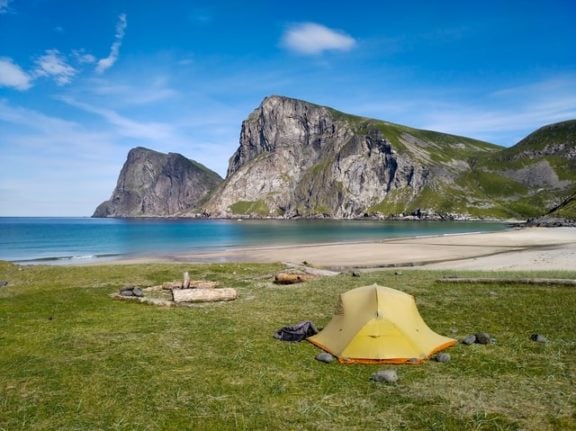Allmennhetens høstingsrett – public right to harvest
Without a doubt, one of the best things about Norway is that you are never far from nature. In the summer, the countryside is abundant with fresh berries to pick. There’s nothing more relaxing than going berry picking on a summers evening in Norway where it stays light long into the night, before going home to make the berries into a jam to have with some sveler (Norwegian thick pancakes, often served with jam, sour cream or brown cheese).
Luckily Norway’s Outdoors Act means that it’s perfectly legal to pick, harvest or eat any berries, nuts, herbs, mushrooms or plants you come across outside.
Cloudberries, however, are a different story. Cloudberries, or multebær, are a big deal in Norway. In some areas of the country, families will have their cloudberry picking spots, and these spots are closely guarded secrets that very few divulge. This is because they cannot be grown commercially, the season is very short, and they are costly to buy.

This reverence of cloudberries is reflected in the law. When picking cloudberries in the north of the country, you must take care not to pick cloudberries on private property because this is against the law in Nordland and Troms og Finnmark.
Winter tyres
Driving regulations in Scandinavia are strict and Norway is no different. This is no surprise given the weather. That’s why there are seasons for summer and winter tyres. You can use either regular winter tyres or “studded” winter tyres in Norway. In most of the country, you can use studded tyres from November 1st until the first Monday after the second day of Easter (April 12th in 2021).
If you are still using studded tyres, it is best to swap over to summer tyres or regular winter tyres. If you are caught driving with studded tyres illegally you could be fined 1,000 kroner.
This includes driving with studded tires outside of the season or not having the proper tread of 3mm.
Buying alcohol on a Sunday
Alcohol in Norway is not only expensive but also state-regulated. Any drink stronger than 4.7 percent can only be sold at state-run wine monopolies, which close at 6pm during the week, but remain closed on Sundays.
Weaker alcohol like beer and cider can be bought in supermarkets until 8pm on weekdays and 6pm on Saturdays. Shops are banned from selling alcohol on Sunday through the Alcohol Act.
Explained: What you need to know about buying alcohol in Norway
Buying wine after 3pm on Saturdays
On Saturdays, the wine shops close at 3pm, which means those wanting something stronger than beer will have to wait until Monday. Around 2.30pm on Saturdays there will be long lines of Norwegians trying to get their wine fix before the shops close.
A handy Norwegian phrase to know is: Jeg må rekke polet – ‘I have to make the pol’ (polet is co short for vinmonopolet – the wine monopoly shops). At rekke polet is seen as a legitimate excuse for missing other things in Norway.
Allemannsretten – the right of public access
The right of public access gives anyone the right to travel or camp in Norway, regardless of who owns the land.
The law gives an unrestricted right of movement to everyone on foot or, in typically Norwegian fashion, skis. It is a public right based on the country’s cultural heritage. However, camping must take place more than 150 meters away from an inhabited house or cottage. The exception to this rule is cultivated land. And if you are going to camp in the same spot for more than one night you’ll need the land owner’s permission.

Neutering your dog
One for the pet owners. Nowadays, it’s common for people to neuter or spay their dogs. Some believe it will improve their temperament and behaviour and also help their pet live a longer, happier life.
In Norway, it is illegal to perform surgical procedures on animals unless it is strictly necessary for their health. This law is under the Norwegian Animal Welfare Act. You can, however, have your dog neutered or spayed if it will improve their health, for example, if you have a female dog prone to urine infections.
In terms of behavioural problems, vets in Norway recommend proper training over unnecessarily neutering your dog. You can, however, spay or neuter your cat.
Lighting bonfires during certain times of the year
Norwegians love to barbecue their pølser (sausages), pinnebrød (stick bread) and other hiking snacks when out in the wild during winter, and lighting a bonfire is a public right that features in Allemannsretten.
But from April 15th and September 15th, bonfires are banned in Norway, which means anyone keen to light a fire will have to get permission from local authorities first. The exception to the rule is areas where it “obviously” won’t start a fire, however local rules sometimes vary on this.
Svalbard
Svalbard is an archipelago located roughly between the Norwegian mainland and the North Pole. It’s a popular tourist destination. Many travel there for the midnight sun in the summer, northern lights in the winter or its glaciers and arctic wildlife.
Its administrative capital Longyearbyen is the world’s northernmost town and home to some of the strangest laws in all of the world, let alone Norway.
Firstly, no one can be buried on the island. Due to permafrost, bodies buried in Svalbard don’t decompose. In the 1990s, scientists discovered somebody who died during the Spanish Flu epidemic. The body still contained the virus, fully preserved. People who die on Svalbard are shipped to the mainland. This also applies to anyone who is in ill-health and could die imminently.
Secondly, cats are not allowed on the island to protect rare arctic birds.
And Norway’s strict alcohol laws are even stricter here as alcohol sales are rationed.
The monthly quota for Svalbard allows up to two bottles of hard liquor or four bottles of wine, half a bottle of fortified wine and 24 cans of beer.
Finally, you cannot leave town unless you have a gun or accompanied by somebody with a gun. This is due to the large number of polar bears scattered across the archipelago.
Phones
Looking at somebody else’s text messages is undoubtedly frowned upon wherever you are. In Norway, it could land you jail time, as reading somebody else messages is considered a violation of the right to private communication.
This applies to secretly recording conversations, opening letters not addressed to you, or delaying, modifying, distorting or destroying a form of communication meant for somebody else. Anyone who violates this right could face a fine or two years in prison.
Breakdowns
Car problems are stressful wherever you are in the world. Before setting off in Norway, you’ll need to be sure you’ve got a reflective vest in the car with you. Not only that, but you must keep it an arm’s length away from you. The reflective vest is to be worn if you break down and have to abandon your car. This is because not many roads in Norway are lit at night outside of motorways, main roads, or towns.
Not only that, but when you leave your car, you must mark the vehicle with a red reflecting triangle to make sure other drivers can see your vehicle.
Television tax
Television licenses are commonplace around Europe. The good news is that Norway has scrapped its television license. The bad news is that they replaced it with a television tax. Luckily, the tax is cheaper than the previous licence, and the amount of tax you pay is based on your earnings. The tax now costs between 200 and 1,700 kroner depending on how much money you earn. Previously the licence was 3,000 kroner. Everybody over the age of 17 has to pay the tax.



 Please whitelist us to continue reading.
Please whitelist us to continue reading.
Member comments